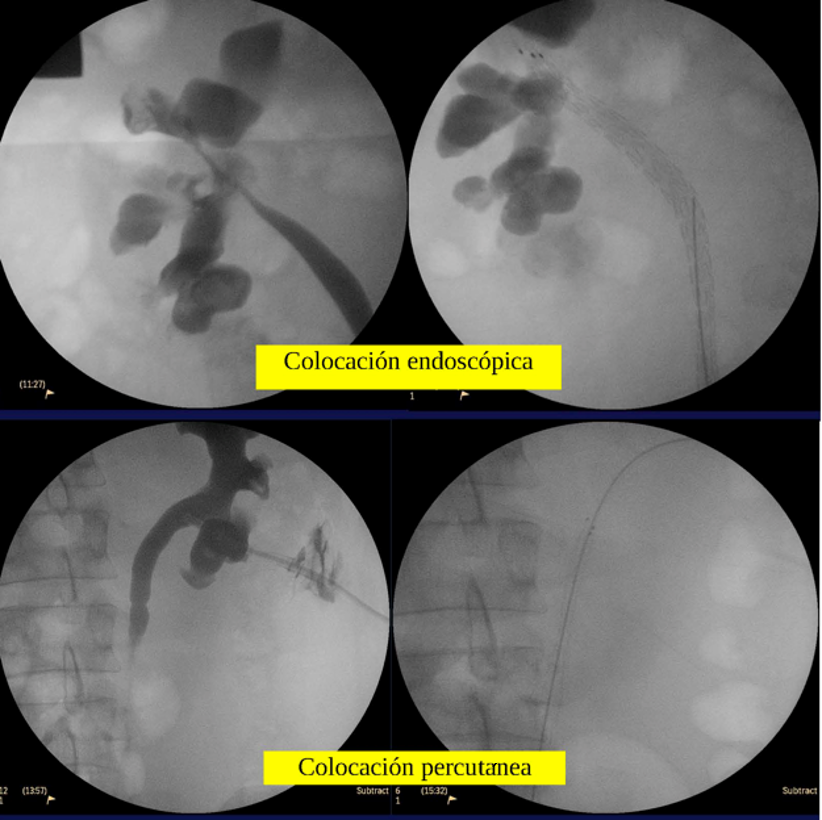Empleo del estent ureteral autoexpandible como tratamiento alternativo de la obstrucción del tracto urinario superior
Texto completo:
PDF
Resumen
Introducción: El tratamiento de la obstrucción del tracto urinario superior es quirúrgico y son múltiples las opciones terapéuticas. A pesar del uso adecuado de las técnicas mínimamente invasivas, aún existen casos con resultados desfavorables que deben mantener derivaciones urinarias permanentemente. Como alternativa, se ha preconizado el empleo de prótesis ureterales metálicas autoexpandibles.
Objetivo: Mostrar los resultados preliminares del empleo del estent ureteral autoexpandible Allium en Cuba.
Material y método: Estudio prospectivo y descriptivo en 12 pacientes, a quienes se les colocaron 13 estents ureterales autoexpandibles Allium entre 2018 y 2019. Se aplicaron estadísticas descriptivas: frecuencia absoluta y distribución porcentual.
Resultados: La edad promedio fue 49,4 años y el 76,9 % eran masculinos. La causa más frecuente de la estenosis fue el tratamiento endoscópico reiterado de litiasis urinaria (69,2 %). El 91,6% de los pacientes egresaron al día siguiente de la cirugía. Se reportaron complicaciones en cuatro (30,7 %). El tiempo de permanencia del estent abarcó entre nueve y 24 meses para un promedio de 18,2 meses.
Conclusiones: La colocación de estent ureteral autoexpandible es una alternativa factible y segura para el tratamiento de la obstrucción del tracto urinario superior en pacientes seleccionados. Constituye una opción terapéutica mínimamente invasiva que debe considerarse en Cuba para los pacientes que tienen otras derivaciones urinarias permanentes como catéter ureteral JJ o sonda de nefrostomía. Sería conveniente una evaluación futura considerando un plazo mayor de colocación del estent.
Palabras clave
Referencias
Martín EM, González IF, Casamayor MP, Margallo FMS, Gálvez FS. Stents ureterales metálicos: Presente y futuro. Arch Esp Urol. 2016 [acceso 20/01/2020];69(8):583-94. Disponible en: https://medes.com/publication/115869
Treacy PJ, Rastinehad AR, Imbert de la Phalecque L, Albano L, Durand M. Endoureteral management of renal graft ureteral stenosis by the use of long-term metal stent: an appealing treatment option. J Endourol. 2016 [acceso 20/01/2020];2(1):155-8. Disponible: https://doi.org/10.1089/cren.2016.0084
Wein AJ KL, Partin AW, Peters CA. Campbell-Walsh Urology. In: Nakada SY BS, editor. Management of upper urinary tract obstruction. 11th ed. Philadelphia 2016. p. 1104-47.
Salamanca-Bustos J, Gómez-Gómez E, Campos-Hernández J, Carrasco-Valiente J, Ruiz-García J, Márquez-López F, et al. Initial experience in the use of novel auto-expandable metal ureteral stent in the treatment of ureter stenosis in kidney transplanted patients. Transplant Proc. 2018 [acceso 13/01/2020];50(2):587-90. Disponible en: https://www.ncbi.nlm.nih.gov/pubmed/29579860
Bahouth Z, Meyer G, Halachmi S, Nativ O, Moskowitz B. Multicenter experience with allium ureteral stent for the treatment of ureteral stricture and fistula. Harefuah. 2015 [acceso 19/01/2020];154(12):753-6. Disponible en: https://europepmc.org/abstract/med/26897774
Bahouth Z, Moskovitz B, Halachmi S, Nativ O. Allium Stents: A novel solution for the management of upper and lower urinary tract strictures. Rambam Maimonides Medical J. 2017 [acceso 10/01/2020];8(4). Disponible: https://www.ncbi.nlm.nih.gov/pmc/articles/PMC5652934/
Mosayyebi A, Vijayakumar A, Yue QY, Bres-Niewada E, Manes C, Carugo D, et al. Engineering solutions to ureteral stents: material, coating and design. Cent European J Urol. 2017 [acceso 19/01/2020];70(3):270-4. Disponible en: https://www.ncbi.nlm.nih.gov/pmc/articles/PMC5656375/
Sampogna G, Grasso A, Montanari E. Expandable metallic ureteral stent: indications and results. Minerva Urol Nefrol. 2018 [acceso 19/01/2020];70(3):275-85. Disponible en: https://www.ncbi.nlm.nih.gov/pubmed/29595037
Kallidonis P, Kotsiris D, Sanguedolce F, Ntasiotis P, Liatsikos E, Papatsoris A. The effectiveness of ureteric metal stents in malignant ureteric obstructions: A systematic review. Arab J Urol. 2017 [acceso 19/01/2020];15(4):280-8. Disponible en: https://doi.org/10.1016/j.aju.2017.08.004
Sali GM, Joshi HB. Ureteric stents: Overview of current clinical applications and economic implications. Int J Urol. 2020 [acceso: 13/01/2020];27(1):7-15. Disponible en: https://onlinelibrary.wiley.com/doi/full/10.1111/iju.14119
Wiesinger CG, Lee J, Herrera-Cáceres JO. Future developments in ureteral stents. Curr Opin Urol. 2019 [acceso 19/01/2020];29(2):124-8. Disponible en: https://www.ncbi.nlm.nih.gov/pubmed/30531433
Tailly T, Denstedt JD. Fundamentals of urinary tract drainage. In: Wein AJ, Kavoussi LR, Partin AW, Peters CA, editors. Campbell-Walsh Urology. 11th ed. Philadelphia, USA: Elsevier, Inc.; 2016. p. 119-35.
Turner EE, Jenks M, McCool R, Marshall C, Millar L, Wood H, et al. The Memokath-051 stent for the treatment of ureteric obstruction: A NICE medical technology guidance. Applied health economics and health policy. 2018 [acceso 19/01/2020];16(4):445-6. Disponible en: https://www.ncbi.nlm.nih.gov/pmc/articles/PMC6028873/
Salciccia S, Sciarra A, Polese M, Giorgio A, Maggi M, Gentilucci A, et al. Loss of Renal Function After Retrograde Ureteral Placement of an Allium Stent for Severe Ureteral Stricture. J Endourol. 2018 [acceso 20/01/2020];4(1):9-11. Disponible en: https://www.ncbi.nlm.nih.gov/pubmed/29392185
Ditz I, Bizjak J. A Rare Case Report of the Use of Allium Stent in Management of a Gunshot Injury with Incomplete Tear of the Proximal Part of the Right Ureter. J Endourol. 2019 [acceso 19/01/2020];5(4):154-6. Disponible en: https://doi.org/10.1089/cren.2019.0044
Ditz I, Bizjak J. The use of Allium™ stent in management of a gunshot injury with incomplete tear of the proximal part of the right ureter. European Urology Supplements. 2019 [acceso 19/01/2020];18(2):e2367. Disponible en: https://doi.org/10.1016/S1569-9056(19)32066-4
Liu K-L, Lee B-C, Ye J-D, Chang Y-H, Chang C-C, Huang K-H, et al. Comparison of single and tandem ureteral stenting for malignant ureteral obstruction: a prospective study of 104 patients. Eur Radiol. 2019 [acceso 19/01/2020];29(2):628-35. Disponible en: https://www.ncbi.nlm.nih.gov/pubmed/29974220
Moskovitz B, Halachmi S, Nativ O. A new self-expanding, large-caliber ureteral stent: results of a multicenter experience. J Endourol. 2012 [acceso 19/01/2020];26(11):1523-7. Disponible en: https://www.ncbi.nlm.nih.gov/pubmed/22697886
Oderda M, Lacquaniti S, Fasolis G. Allium stent for the treatment of a malignant ureteral stenosis: A paradigmatic case. Urologia J. 2018 [acceso 19/01/2020];85(2):87-90. Disponible en: https://www.ncbi.nlm.nih.gov/pubmed/28623649
Guandalino M, Droupy S, Ruffion A, Fiard G, Hutin M, Poncet D, et al. The Allium ureteral stent in the management of ureteral stenoses, a retrospective, multicenter study. Prog Urol. 2017 [acceso 13/01/2020];27(1):26-32. Disponible en: https://www.ncbi.nlm.nih.gov/pubmed/27988175

Esta obra está bajo una licencia de Creative Commons Reconocimiento-NoComercial 4.0 Internacional.




 La revista está: Certificada por el CITMA
La revista está: Certificada por el CITMA La revista es de acceso abierto y gratuito.
La revista es de acceso abierto y gratuito.